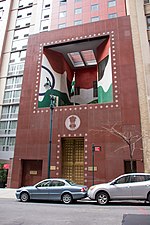42nd Street station (IRT Second Avenue Line)
Defunct New York City Subway stations located abovegroundFormer elevated and subway stations in ManhattanIRT Second Avenue Line stationsManhattan railway station stubsRailway stations closed in 1942
The 42nd Street station was an express station on the demolished IRT Second Avenue Line in Manhattan, New York City. It had three tracks and two island platforms. The next stop to the north was 50th Street for local trains and 57th Street for express trains. The next stop to the south was 34th Street for local trains and 14th Street for express trains. The station closed on June 13, 1942.
Excerpt from the Wikipedia article 42nd Street station (IRT Second Avenue Line) (License: CC BY-SA 3.0, Authors).42nd Street station (IRT Second Avenue Line)
2nd Avenue, New York Manhattan
Geographical coordinates (GPS) Address Nearby Places Show on map
Geographical coordinates (GPS)
| Latitude | Longitude |
|---|---|
| N 40.749813888889 ° | E -73.972197222222 ° |
Address
Sussex
2nd Avenue
10035 New York, Manhattan
New York, United States
Open on Google Maps






